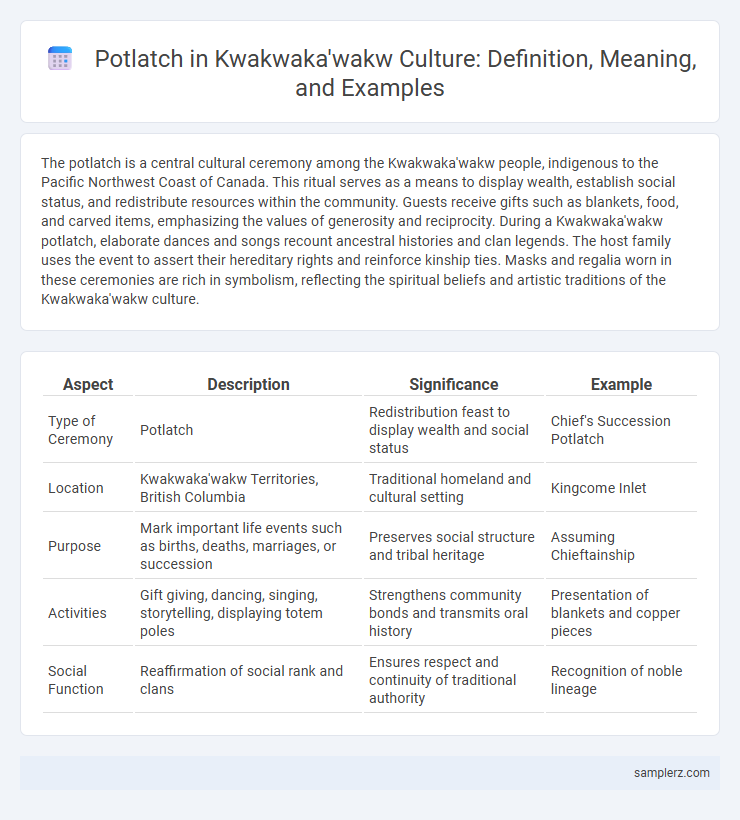The potlatch is a central cultural ceremony among the Kwakwaka'wakw people, indigenous to the Pacific Northwest Coast of Canada. This ritual serves as a means to display wealth, establish social status, and redistribute resources within the community. Guests receive gifts such as blankets, food, and carved items, emphasizing the values of generosity and reciprocity. During a Kwakwaka'wakw potlatch, elaborate dances and songs recount ancestral histories and clan legends. The host family uses the event to assert their hereditary rights and reinforce kinship ties. Masks and regalia worn in these ceremonies are rich in symbolism, reflecting the spiritual beliefs and artistic traditions of the Kwakwaka'wakw culture.
Table of Comparison
| Aspect | Description | Significance | Example |
|---|---|---|---|
| Type of Ceremony | Potlatch | Redistribution feast to display wealth and social status | Chief's Succession Potlatch |
| Location | Kwakwaka'wakw Territories, British Columbia | Traditional homeland and cultural setting | Kingcome Inlet |
| Purpose | Mark important life events such as births, deaths, marriages, or succession | Preserves social structure and tribal heritage | Assuming Chieftainship |
| Activities | Gift giving, dancing, singing, storytelling, displaying totem poles | Strengthens community bonds and transmits oral history | Presentation of blankets and copper pieces |
| Social Function | Reaffirmation of social rank and clans | Ensures respect and continuity of traditional authority | Recognition of noble lineage |
Origins of Potlatch in Kwakwaka'wakw Tradition
The potlatch in Kwakwaka'wakw culture originated as a ceremonial feast integral to social structure and spiritual beliefs, dating back centuries among Indigenous peoples of the Pacific Northwest Coast. Rooted in complex kinship systems and reciprocal gift-giving, the potlatch served to reaffirm status, distribute wealth, and commemorate significant events such as births, marriages, and funerals. This tradition reflects ancestral connections and the Kwakwaka'wakw's understanding of community, identity, and the spiritual world.
The Potlatch Ceremony: Structure and Significance
The Potlatch ceremony in Kwakwaka'wakw culture is a complex social event involving gift-giving, feasting, dancing, and the transfer of titles and privileges. Structured around clan leaders who host and distribute wealth to assert status and reinforce social bonds, the ceremony functions as a vital mechanism for cultural continuity and wealth redistribution. Its significance lies in affirming identity, spiritual beliefs, and community cohesion through symbolic acts and traditional protocols.
Chiefly Roles and Responsibilities During Potlatch
In Kwakwaka'wakw culture, the potlatch ceremony centers around chiefly roles that assert social status, redistribute wealth, and reinforce community bonds. Chiefs are responsible for organizing the event, distributing gifts, and performing rituals that validate their authority and lineage. These duties solidify the hierarchical structure and spiritual significance within the Kwakwaka'wakw society during the potlatch.
Symbolic Gift-Giving and Redistribution of Wealth
In Kwakwaka'wakw culture, the potlatch serves as a powerful ceremony where symbolic gift-giving embodies social status and spiritual reciprocity. Wealth redistribution occurs as hosts present valuable items such as blankets, masks, and copper shields, reinforcing alliances and social hierarchy. This ritual fosters community cohesion by balancing wealth disparities and affirming cultural identity through shared generosity.
Potlatch as a Marker of Social Status
The potlatch in Kwakwaka'wakw culture functions as a vital marker of social status, where leaders demonstrate wealth and prestige by distributing lavish gifts and hosting elaborate feasts. This ceremonial event reinforces hierarchical structures and validates the host's rank within the community through reciprocal exchanges and ancestral storytelling. The scale and generosity of the potlatch directly reflect the social standing and influence of the family or clan involved.
Rituals, Performances, and Ancestral Stories
The Kwakwaka'wakw potlatch features elaborate rituals including the Kwakwaka'wakw dance ceremonies where participants wear intricate masks and regalia representing ancestral spirits. Performances during the potlatch reenact sacred myths, preserving oral histories and reinforcing community bonds through storytelling. Ancestral stories conveyed in these rituals emphasize themes of transformation, social status, and the spiritual connection between the living and their ancestors.
Impact of Colonial Bans on Potlatch Practices
Colonial bans imposed on the Kwakwaka'wakw potlatch disrupted generations-old traditions, forcing secretive gatherings and the loss of cultural knowledge. Legal restrictions from the late 19th to mid-20th century criminalized potlatch ceremonies, undermining social hierarchy and communal wealth redistribution essential to Kwakwaka'wakw identity. Despite prohibition, resilience in preserving potlatch practices fostered cultural revival and strengthened Indigenous rights movements in modern times.
Modern Revivals and Adaptations of Potlatch
Modern revivals of the Kwakwaka'wakw potlatch emphasize the preservation of traditional dance, song, and ceremonial regalia, adapting these elements to contemporary community contexts. Cultural organizations and Indigenous leaders collaborate to host potlatches that reinforce identity and educate younger generations while navigating legal and social frameworks established since historic potlatch bans. These adaptations showcase the resilience of Kwakwaka'wakw cultural heritage, blending ancestral customs with modern expressions of Indigenous sovereignty and cultural celebration.
Potlatch in Kwakwaka'wakw Identity and Community
The potlatch in Kwakwaka'wakw culture serves as a vital ceremony for affirming social status and reinforcing community bonds through the lavish distribution of gifts. This ceremonial event epitomizes the Kwakwaka'wakw identity by showcasing ancestral narratives, art, and dance, thereby strengthening cultural continuity and communal respect. Rituals performed during potlatch also function as public affirmations of lineage and rights, solidifying the collective identity within the Kwakwaka'wakw nation.
Examples of Historic and Contemporary Kwakwaka'wakw Potlatches
Kwakwaka'wakw potlatches historically involved the redistribution of wealth through elaborate gift-giving ceremonies that reinforced social status and kinship ties. Notable examples include Chief George Hunt's early 20th-century potlatches, which combined traditional dances, songs, and the presentation of carved masks to assert lineage and clan rights. Contemporary potlatches continue this legacy, such as recent celebratory events honoring cultural resurgence, where modern artistic expressions blend with ancestral customs to sustain Kwakwaka'wakw identity.

example of potlatch in Kwakwaka'wakw culture Infographic
 samplerz.com
samplerz.com